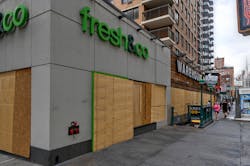Last week marked the one-year anniversary of the death of George Floyd, an event that will likely be a watershed moment for modern policing and race relations in America for years to come. However, the protests that followed in the weeks and months immediately following Floyd’s death, some of which devolved into riotous behavior, also left an indelible mark on the country and on the business community.
Acts of looting left a devastating trail of damage amongst businesses of all sizes in the communities where they occurred and have led many organizations to rethink risk mitigation strategies in confronting these types of events. Historically, incidents of civil unrest were isolated to individual cities and were infrequent occurrences, but the proliferation of social media and the speed with which information flows today has resulted in a paradigm shift in how these types of events unfold.
One person who has been at the forefront of helping businesses analyze the security failings of last summer and develop future mitigation strategies is Allison Wood, who heads up the political risk consulting practice in the U.S. and Canada at global risk consultancy firm Control Risks. SecurityInfoWatch.com (SIW) recently caught up with Wood to discuss the lessons learned from the recent rise in civil unrest and best practices organizations can employ when responding to future incidents.
SIW: How do you think businesses and particularly retailers are going to address civil unrest mitigation moving forward given what we saw last summer?
Wood: There are a couple of things that we have seen businesses do in response to what we saw last summer. One of those things is to put more robust plans and procedures in place around what those retail facilities should do in cases of civil unrest. Certainly, after we saw that initial wave of rioting and violence, we saw some organizations take more proactive steps to just sort of shut down operations or board up windows in advance of dates that were expected to prompt unrest. But, of course, these types of solutions are costly and disruptive to retailers, in particular. What we have seen is a combination of security teams working to ensure that store managers and employees know how to respond in cases of civil unrest but also to try and use analysis and intelligence to understand where these protests are likely to happen and track anniversaries so they can be as prepared as possible and make sure their people are aware of that as well.
SIW: Where were some of the biggest gaps in the existing plans of businesses to address these types of incidents?
Wood: Some of those gaps were in ensuring those people in charge of stores on the ground knew how to respond to these types of events rather than it just being a function of a security team at headquarters and making sure those local personnel understand who they can contact for assistance in those types of cases. That is a gap that we’ve seen some of our clients work to address. Another thing worth raising, and that has become an issue for some companies, was how civil unrest affects employees’ ability or willingness to come to work in an area that might be impacted by unrest. I mean that both in terms of practical issues in getting to work – if public transit routes are blocked because of protests – but also more personal safety concerns. An example being if someone calls in sick because they are fearful that a protest might occur. That is another thing we’ve seen -- businesses just try to become more aware of and communicate with employees that they are taking measures to ensure their safety and are actively tracking these activities and taking those steps along the way.
SIW: What are some of the biggest pitfalls that organizations need to avoid when they are both planning for civil unrest and addressing it as it is unfolding?
Wood: One thing that has always been important but certainly something that has been highlighted as a result of the unrest activities related to George Floyd, but also the election, is just the need for communication across an organization. It is not uncommon to see parts of the organization siloed, particularly sometimes between security and maybe a communications or public relations team, and it may be that representatives of those parts of the business might fit together as a crisis management team, but ideally as we are seeing so many businesses make statements to respond to these issues, it is more important now than maybe in the past for these teams to be in communication with each other so there is a two-way conversation about how those types of discussions can affect security and to have reassurances on both sides as well.
SIW: What are some other things that businesses need to do in being proactive when potentially volatile situations like this arise?
Wood: We always recommend for companies, especially those that have retail locations in cities where there is a strong track record of activism and protests and civil unrest, to monitor these situations and have awareness of when and where some of these events are likely to occur. This sort of broad need to have guidance and processes in place across all locations is important. One reason I say that is because we have seen, on a couple of different occasions now, unrest and violent unrest at that, breakout across the country in response to a certain event. And the tricky part with that is that it is very difficult to predict when and where that is going to happen because it is event-driven, and that underlines the importance of that training and guidance in place across an organization.
About the Author:
Joel Griffin is the Editor of SecurityInfoWatch.com and a veteran security journalist. You can reach him at [email protected].



